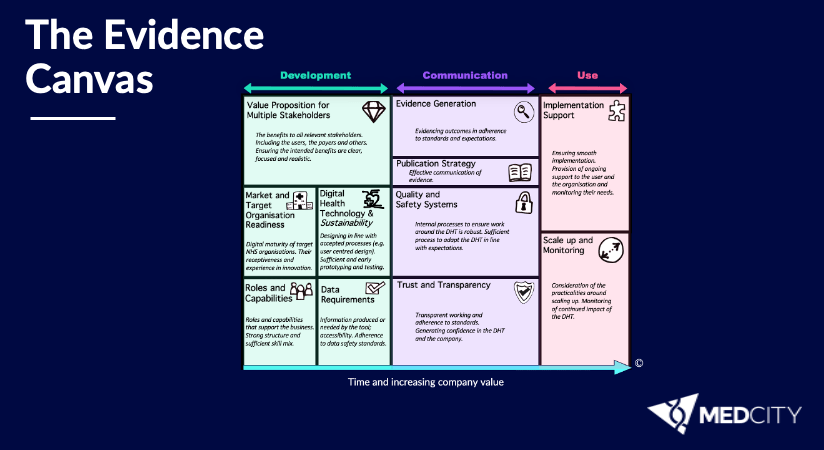
Introducing the MedCity Evidence Canvas
Digital healthcare products and services have boomed since COVID-19. However one of the biggest challenges facing developers remains generating the right evidence to demonstrate the effectiveness of their technologies in meeting the needs of patients and the healthcare system. To help digital health innovators navigate the process and build an effective business model, MedCity has developed The Evidence Canvas.
Find out more about the Canvas
What is the MedCity Evidence Canvas?
The MedCity Evidence Canvas is a tool that helps digital health companies at varying stages in their development work out what kind of data they need to generate, and who to present this data to.
Arising out of a need to help life science companies achieve commercialisation of their products and services, and with experience gained by supporting lots of clients within accelerators and grant-funded programmes, the Evidence Canvas was co-designed and validated by MedCity CEO Neelam Patel, together with former UCL intern Lucille Harvey. It provides clarity to scaling companies, acting as a single framework outlining the key elements that need to be considered in both building a company and commercialising products.
Evidence generation is central to the support offered by the Canvas. Generating evidence is vital to the commercialisation and adoption of any innovation in life sciences and this goes beyond the often thought of aspects, such as clinical trial and research evidence. The Canvas encourages companies to consider what evidence to present to different stakeholders within the ecosystem, from investors and regulators, to health care professionals and patients. A central purpose of the Canvas is to get companies to think about who they’re speaking to in their presentation of evidence, and who their stakeholders are.
Whilst the Canvas has been designed to benefit life science SMEs at any stage of their development journey, the phases of development that it covers means that it will be particularly useful to early stage (pre-clinical) innovators. The three main phases covered by the Canvas are Development, Communication and Use, with each of these broken down into a comprehensive range of subsections.
The Three Phases: Development, Communication and Use
1: Development
The first phase, Development, focuses on the shaping and fulfilment of core strategies, particularly the value proposition and how companies can showcase this from different angles, depending on the stakeholders they’re working with. This encourages companies to think about development from the perspective of external factors, such as market receptiveness to this type of technology and adhering to data standards, as well as internal factors, such as the balance of roles and capabilities within the team.
2: Communication
The second phase, Communication, brings evidence generation together with some of the wider aspects surrounding it. This can help companies position innovations towards integration into the ecosystem. The key components to consider are broken down into ‘publication strategy’, ‘quality & safety systems’, and ‘trust & transparency’. These different components encourage companies to think about how their data is being disseminated to different stakeholders, and how they can ensure consistency between the data being presented and the core message of their product. In looking at and balancing these aspects of communication, companies can develop understanding of how they can utilise and present their evidence to gain confidence in their innovation.
3: Use
The third area, Use, focuses primarily on the components of ‘implementation & support’, and ‘scale-up & monitoring’. We’ve found that companies with innovative technologies often overlook how their technology is going to be implemented, and this part of the Canvas highlights how important it is for companies to consider this early on. Looking at the pathways of a particular technology, identifying who the key stakeholders are and factoring them into plans for study/research are examples of how companies can focus on these aspects.
How can the Evidence Canvas help companies?
One advantage of using the Evidence Canvas is its flexibility. Although it is loosely sequential, companies can use the framework across multiple stages of development to support constructing a business plan. In this way, the Canvas can be highly useful for self-evaluation, helping companies to understand their strengths and weaknesses.
The Canvas can help businesses identify whether their strategy should be aimed towards generating more data or effectively using and disseminating data already gathered, whilst at the same time finding evidence gaps, and building a strategy around this. The strategy developed with these pointers can provide a path to help companies demonstrate the evidence gathered and comply with some of the key regulatory materials needed to move forwards, such as the NICE Evidence Standards Framework and Digital Technology Assessment Criteria (DTAC).
The Canvas has proven highly valuable to many of our SMEs. Anjna Sharma from Soar Beyond highlighted how the Evidence Canvas brought clarity to the company’s marketing strategy, saying:
“I’d really recommend the Canvas to be used; it has helped us turn what we initially thought was a daunting activity of creating a marketing strategy, into a really simplified task that we can actually see ourselves using for some of our other products.”
Dr Robbie Huddleston from Surgery Hero also highlighted the value that the Canvas brought to the company, saying:
“The Evidence Canvas has been really helpful for adding structure to our evidence generation process – giving clarity to our strategy and what we’re looking to achieve.”